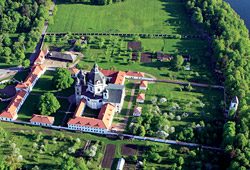History
The sanctuary was built for the Camaldolese monks by Kristupas Žygimantas Pacas (1621–1684), the chancellor of the Grand Duchy of Lithuania. The monks and their patron agreed to situate the monastery not far from Kaunas, on the small hill of Pažaislis, in the woods near a bend in the Nemunas River. The Latin name initially chosen for the monastery, Monte Pacis, can be translated to reflect both the tranquillity of life at the place (“Mountain of Peace”) and the name of its patron (“Mountain of Pacas”).
Construction of the stone monastery and church began in 1667. The Church of the Visitation of the Blessed Virgin May took shape over several years and was blessed in 1674, although the towers on its façade were not completed until 1681. The monastery and other buildings in the complex took longer to complete and decorate. Several Italian architects were involved, among whom Pietro Puttini (1633–1699) stands out for having dedicated the longest period of time. At Pažaislis from 1673 to 1691, he oversaw construction and planned most of the interior decoration. Two other Italians involved in the construction of Pažaislis include the architect Isidoro Affaitatti (1622–c.1686) and the engineer Giovanni Batista Frediani († after 1693).
Decoration of the church’s interior began in 1673 as construction work neared its end. The church building, parts of the monastery and the guest lodgings were embellished with stucco art and, a bit later, paintings. The marble work in the church took almost 20 years. The sanctuary’s stucco sculptures were created between 1674 and 1676 by the Italian decorator Giovanni Batista Merli. Florentine artist Michelangelo Palloni (1637–1712) painted the frescos between 1678 and 1685.
The church of the Pažaislis monastery was given the title Visitation of the Blessed Virgin Mary on October 15, 1712, even though construction work continued on the monastery itself. Cell-huts for the hermit monks were not completed until almost the middle of the 18th century, while the bell tower of the hermitage was not put in place until the second half of the 18th century. In 1791–1792, the eastern façade of the church was strengthened with an adjunct stone edifice designed in the classicist style by Pietro Rossi (1761–1831).
Napoleon’s soldiers did damage to the monastery in 1812. They stole some of the liturgical vessels as well as 6 of 12 ivory statues that adorned the main altar. Tsarist authorities closed the monastery in 1831 after accusing the Camaldolese monks aiding insurgents. A year later both the church and the monastery were handed over to Orthodox believers. On that occasion, altars were removed, the white habits of the monks in the frescos of the dome were painted black and frescos between the arches in the central nave were altered or completely repainted. In 1877 most of the small hermit dwellings were demolished, leaving only the three that stand today.
German soldiers who lodged at the monastery in 1915 wreaked havoc on the complex. Among other things, they tore the copper roofing off the buildings and put it to military use.
In 1920, the monastery was entrusted to sisters from the Congregation of St Casimir who had come to Lithuania from Chicago. Finding the church and monastery badly damaged and looted, they initiated repairs that took many years.
The Soviet authorities evicted the Sisters of St Casimir from Pažaislis in 1948 and closed the monastery. After that, the complex changed hands several times, serving as a state archive, a tourist resort and a psycho-neurological hospital. From 1967 to 1992 it was a branch of the M. K. Čiurlionis Art Museum, during which time renovation of the buildings’ interiors and exteriors was undertaken. Construction of the Kaunas Hydroelectric Plant dramatically altered the landscape surrounding the monastery. When the Nemunas was dammed in 1959, what had been a bend in the river became the Kaunas Reservoir. Its waters now covered the old cemetery of the Camaldolese monks and the ruins of the little hillside Church of St Anne. Mount Pažaislis, once visible from a great distance, became a small hill on the shore of a lake.
The Pažaislis monastery was returned to the Sisters of the Congregation of St Casimir on June 15, 1992. Thanks to them, the complex has become not just a home for their congregation but a true spiritual hub. Retreats are now organized for diverse groups of people at Pažaislis, which also opens its doors to new social and cultural traditions. Visitors are acquainted with the monastery’s artistic riches, and a variety of cultural encounters are held, including evenings of poetry. International music festivals have been held at Pažaislis each summer since 1996, with ever increasing popularity.








